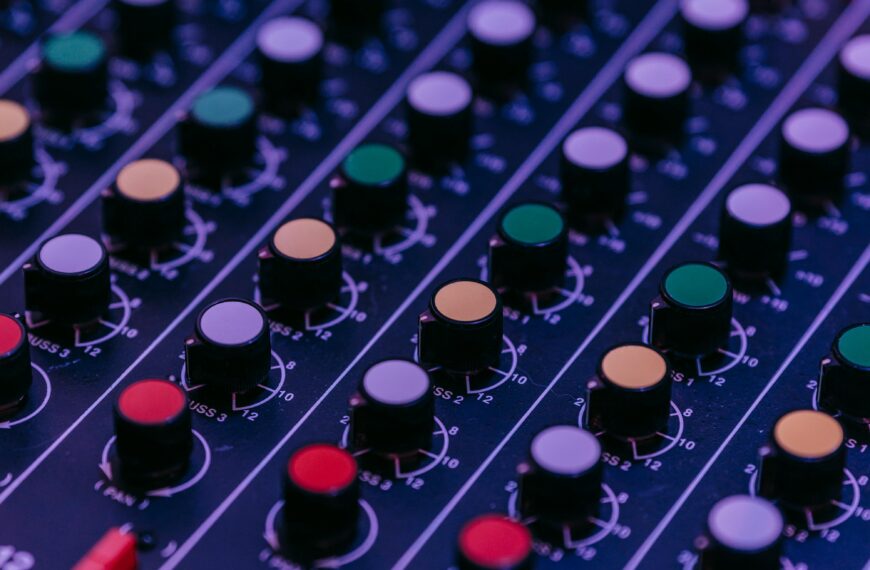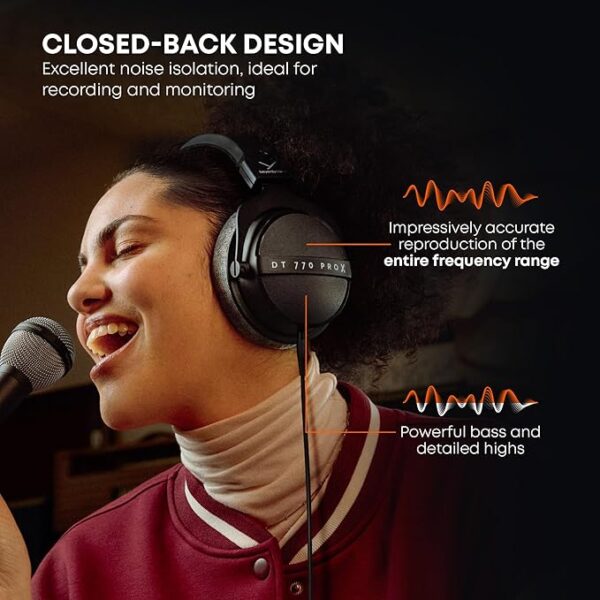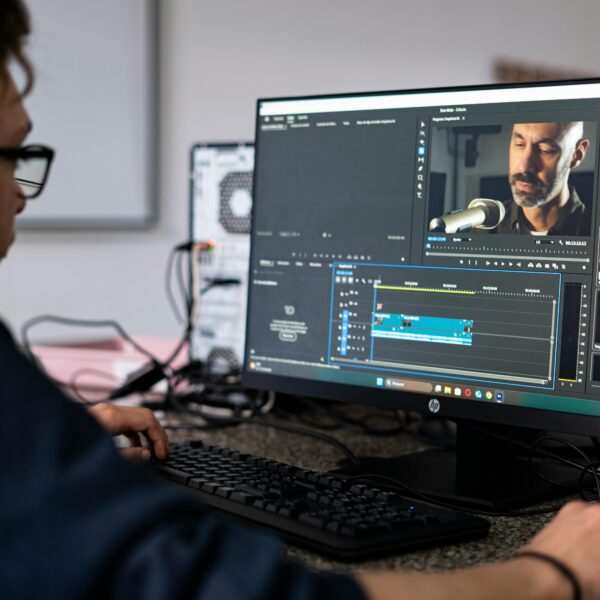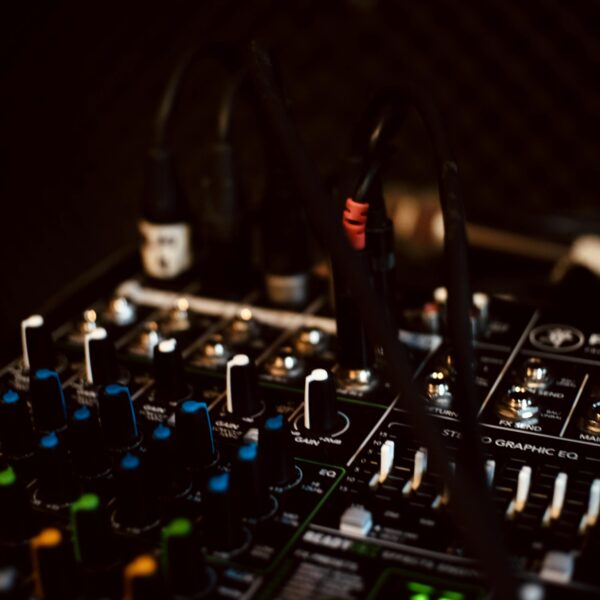In the next few minutes, you’ll know exactly which best USB audio mixer fits your setup, why it’s better, and how to wire it right the first time.
Okay, but…
Want clean recording to a computer? Yes—USB mixers can do that.
Need separate tracks for each mic? Not all USB mixers can.
Streaming with game audio + calls? You’ll want true loopback, not a workaround.
Here’s the thing most guides skip:
Many “USB mixers” only send a stereo mix to your computer—no isolated tracks.
Some don’t support loopback, so your stream can’t hear your system audio.
Driver and latency matter more than flashy FX. That’s why your mic feels “laggy.”
My story?
I grabbed a cheap USB mixer for a two-host show. It sounded fine—until editing.
Both voices were glued into one track. No fixes. No clean cuts. Pain.
That sent me on a deep dive into multitrack USB, loopback, and driver stability.
This guide is different.
No fluff. No specs dump.
Just the 7 mixers that pass real-world tests: multitrack (when you need it), reliable drivers, proper loopback, and quiet USB paths.
If you want the best USB audio mixer for podcasting, streaming, or a compact studio—start here.
I’ll show what to buy, what to avoid, and the exact setup that just works.
Our testing lens (what really matters)
When I say “best,” here’s what I actually measured and prioritized:
- USB path quality & latency. Does it do true multitrack? Does loopback clip or introduce echo? Is latency low enough for plugin monitoring?
- Preamps & headroom. Can it drive dynamic mics (SM7B) without trashing the gain structure?
- Routing & workflow. Mix-minus for call-ins, aux sends for monitors, direct outs, pads, and mute/fader behavior.
- Stability & drivers. Does the unit have a history of flaky drivers or frequent firmware fixes?
- Build & power. Bus-powered when you need it, or solid PSU for long sessions.
- Value for money. Real usable features, not marketing extras.
I’ll use these criteria when recommending each model below.
The unique angle — USB path quality (the part most guides skip)
Most articles list mixers by name and specs. That’s fine, but incomplete.
Here’s what I mean by USB path quality and why it changes everything:
- Stereo USB vs Multitrack USB. Stereo USB sends a summed stereo mix to the computer. Multitrack USB sends each channel (or groups of channels) as separate tracks. If you want to edit individual mics later, multitrack is a must.
- True loopback vs fake loopback. Some mixers provide reliable loopback channels (game audio + mic routed to streaming app cleanly). Others “simulate” loopback and introduce level mismatches, echo, or latency.
- USB chipset & port type. USB-C connectors don’t guarantee better audio; the internal chipset and driver matter. Class-compliant (no drivers) is great for iPad and quick setups. Driver-supported units often unlock multitrack and low latency on Windows/macOS.
- Power/polling & ground loops. Cheap USB implementations can produce hum or a digital “whine.” Good designs isolate analog audio from the digital USB path.
The takeaway: don’t buy a mixer just because it says “USB” — buy it because its USB implementation fits your workflow.
Editor’s picks — Top 7 audio mixers with USB
Below each pick I give: why it’s good, the USB behavior you’ll see, who should buy, and the real drawbacks.
1) RØDECaster Pro II — Best overall for podcast + stream
If there’s one podcast mixer that’s dominated 2025, it’s the Rode Rodecaster Pro II—and for good reason.

This all-in-one mixing board is broadcast quality, touchscreen controlled and next gen processing in a sleek compact unit.
But is it really the best mixer for podcasting or just hype?
I had to try it out.
The Rodecaster Pro II isn’t just a mixer, it’s a podcasting studio in a box.
With its quad core audio engine, customizable sound pads and one touch voice processing you can edit, mix and enhance your podcast without a computer.
The built in APHEX audio processing (used in high end radio stations) makes voices sound rich and professional even if you’re using a budget mic.
I tried plugging in a cheap dynamic mic and the difference was insane!
But what really makes the Rodecaster Pro II shine is its versatility:
- 4 XLR-1/4” combo inputs – Perfect for multi-guest podcasts or adding instruments.
- Multi-track recording – Saves each track separately, so you can fine-tune later.
- Dual USB-C interfaces – Allows you to connect two computers or record from a phone & PC simultaneously.
- Wi-Fi & Ethernet connectivity – Direct firmware updates and cloud-based sound libraries.
- Smart pads for sound effects – Assign jingles, ads, or voice effects with a single tap.
Why it wins: made for podcasters; built-in processing, multitrack USB, pads, and professional routing designed around live shows and streaming.
USB behavior: multitrack, true loopback options, low-latency drivers on macOS/Windows, class-compliant for mobile with limitations. Works with OBS, DAWs, and recording software reliably.
What you’ll love: instant podcast workflow (pads, sound effects, ducking, onboard compressors), excellent preamps, and advanced routing (mix-minus, multiple USB channels).
Real drawbacks: more expensive than basic mixers; complexity can be overkill if you just need stereo USB. Firmware updates are frequent (good), but that means occasionally needing to update drivers.
Ideal user: podcasters and streamers who want a single all-in-one desk that reduces software routing headaches.
2) RØDECaster Duo — Best compact desk setup
When I first got my hands on the Rode Rodecaster Duo,
I was skeptical.
Could a smaller version of the Rodecaster Pro II really deliver the same high-quality audio and versatility?
Turns out,
this compact powerhouse packs a serious punch—though it’s not without its flaws.
For solo podcasters and small teams, the Rode Rodecaster Duo is an absolute game-changer. Here’s why:

- Compact & Portable: Unlike its bulkier sibling, the Rodecaster Duo is designed for creators who need a portable yet powerful podcasting setup. It fits perfectly on a small desk, making it ideal for home studios.
- Broadcast-Quality Preamps: Rode’s Revolution Preamps provide ultra-low noise (-131.5 dBV EIN) and high gain (76 dB), eliminating the need for an external Cloudlifter or FetHead for dynamic microphones like the Shure SM7B.
- Smart Routing & Processing: With APHEX audio processing, built-in noise gate, de-esser, and compressor, your voice will sound studio-level professional without much tweaking. I recorded a podcast episode with a guest over Zoom, and even with background noise, the Duo managed to keep our voices crisp and clear.
- Intuitive Touchscreen Interface: The high-resolution touchscreen makes it incredibly easy to navigate through settings, assign sound pads, and tweak audio levels. Compared to the Tascam Mixcast 4, the UI feels much smoother and more intuitive.
Why it wins: the Pro II’s philosophy in a smaller footprint.
USB behavior: multitrack-capable and class-compliant for mobile. Loopback works well for simple stream setups.
What you’ll love: small footprint, great mic preamps, and the podcast workflow in a desk-friendly size.
Real drawbacks: fewer channels and fewer physical controls than Pro II — but if you don’t need them, this is a better desk presence.
Ideal user: solo creators or dual-host setups with limited desk space.
3) Zoom PodTrak P8 — Best portable podcast workstation
If you’re looking for an affordable, feature-packed mixer that can handle multiple guests, the Zoom PodTrak P8 might just be the best mixer for podcasting on a budget.
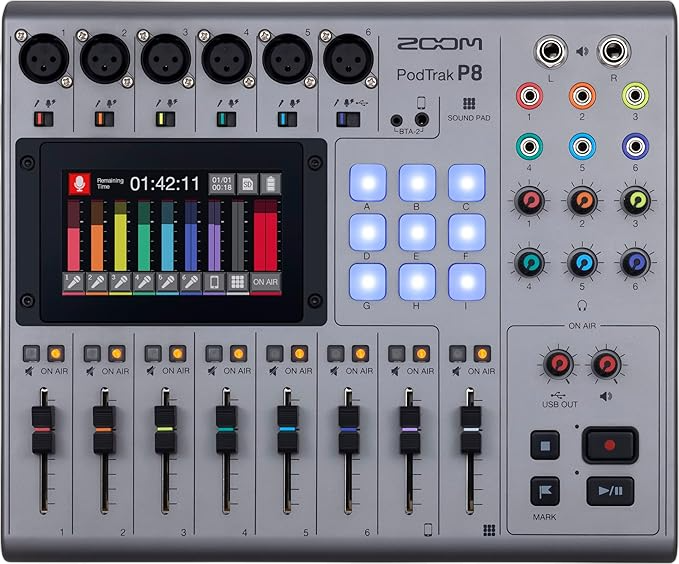
It’s built specifically for podcasters, meaning no unnecessary knobs—just a touchscreen, sound pads, and dedicated controls that make recording effortless.
But is it a real contender against pricier options like the Rodecaster Pro II? I put it to the test.
What immediately stood out to me was the six XLR mic inputs, something rare at this price point.
Each input has dedicated gain controls, meaning you don’t need to fiddle with settings mid-recording.
The built-in color touchscreen is surprisingly intuitive, letting me adjust levels, mute channels, and even apply effects in seconds.
The nine programmable sound pads allow for quick access to intros, ads, or audience reactions, making it easy to add a professional touch.
Here’s what makes the Zoom PodTrak P8 a powerhouse for podcasters:
- 6 high-quality XLR inputs – Ideal for roundtable podcasts or guest interviews.
- Multi-track recording on an SD card – No need for a laptop; record everything on-the-go.
- Mix-minus for phone calls – Ensures crystal-clear remote interviews without echo.
- Battery or USB-powered – Use it anywhere, even without a power outlet.
- Noise reduction & voice enhancement tools – Surprisingly effective for a budget mixer.
Why it wins: built as a portable podcaster’s mixer + recorder, with good USB implementation.
USB behavior: multitrack to PC/Mac, plus standalone recording to SD. Loopback is solid, designed for call-ins.
What you’ll love: dedicated phone/call integration, standalone recording as a backup, and battery/portable operation options.
Real drawbacks: slightly older UI compared to new models; menu navigation takes time to learn.
Ideal user: podcasters who record on location and want built-in backups and phone integration.
4) Behringer Xenyx 1204USB — Best value under tight budgets
The Behringer Xenyx 1204USB is a fantastic choice for those looking for an affordable yet feature-packed mixing board for podcasting.
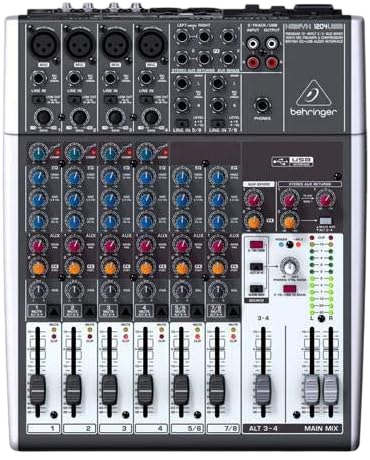
With four Xenyx mic preamps, it delivers clean, high-quality audio that competes with more expensive options.
The neo-classic “British” 3-band EQ on each channel adds warmth and depth, making vocals sound professional and polished.
One of its biggest advantages is the built-in USB/audio interface, which makes it easy to connect directly to a computer for seamless recording.
This is a game-changer for podcasters and home studio users who want a plug-and-play experience without investing in extra gear.
The one-knob compressors on the mic channels are another standout feature, helping to keep vocal levels balanced—especially useful for live streams and interviews.
However, it’s not without its flaws. The EQ section lacks mid-frequency control, which can be limiting when fine-tuning the sound.
Additionally, the USB connection relies on an external adapter instead of being fully integrated, which some users find inconvenient.
From personal experience, setting up the Xenyx 1204USB was incredibly straightforward.
I was able to connect my microphone and instruments in minutes and immediately noticed the rich, full-bodied sound it produced.
The built-in compression made a noticeable difference, preventing sudden volume spikes during my recordings.
With more people diving into podcasting and home recording, demand for budget-friendly mixers has been steadily rising.
Why it wins: very affordable, basic USB connectivity, decent tone for price.
USB behavior: stereo USB, not multitrack. Good for live stereo capture or simple streaming.
What you’ll love: low cost, on-board compressors and effects in some variants, simple and reliable for small setups.
Real drawbacks: stereo USB limits post production flexibility. Preamps and build are fine for home use but not studio-grade.
Ideal user: hobbyists who need a cheap desk mixer to route mic + music to their computer without fancy post needs.
5) Yamaha MG10XU — Small studio workhorse
If you’re the kind of podcaster who wants complete control over sound, but without an overly complicated setup, the Yamaha MG10XU is a solid choice.

This compact 10-channel mixer might not have built-in podcast-specific features like sound pads or a touchscreen, but it makes up for it with rock-solid preamps, versatile connectivity, and studio-quality effects.
I tested it to see if it could keep up with more podcasting-focused mixers—and spoiler alert: it punches well above its weight.
The first thing I noticed was the stellar sound quality.
Yamaha is known for its D-PRE preamps, and the MG10XU delivers clean, low-noise gain, making it ideal for dynamic mics like the Shure SM7B.
Unlike budget mixers that introduce hiss, this one keeps the audio pristine—
something I immediately appreciated when editing my episodes. It has four XLR inputs, which is plenty for most podcasts, plus stereo line inputs for things like music, sound effects, or even a second audio source.
What makes it stand out:
- High-quality D-PRE preamps – Delivers clean, low-noise gain for professional sound.
- Built-in SPX effects – Adds reverb, compression, and EQ tweaks to polish voices.
- USB audio interface – Directly records into software like Audacity, Adobe Audition, or OBS.
- Metal chassis – Unlike plastic mixers, this one feels built to last.
- Flexible input/output options – Works with XLR mics, instruments, and line-level sources.
Why it wins: solid analog build, good FX, Yamaha preamps, and simple USB.
USB behavior: stereo USB out of the box. Reliable USB stack and low noise.
What you’ll love: robust hardware, good preamps, built-in FX that are musical for live use.
Real drawbacks: no multitrack over USB — you’ll record a stereo mix unless you add a separate interface.
Ideal user: small bands, streamers who don’t need multitrack, and home studios that want analog feel.
6) Mackie ProFX10v3 / ProFX — Streamer + live hybrid
The Mackie ProFX10v3 is one of those mixers that really blurs the line between a live gig board and a streaming audio interface.
It’s got Onyx mic preamps with tons of clean gain, so your mics and instruments sound solid. Channels 1–2 even handle guitars directly, plus you get simple extras like one-knob compression, 3-band EQ, and a low-cut filter to clean things up.
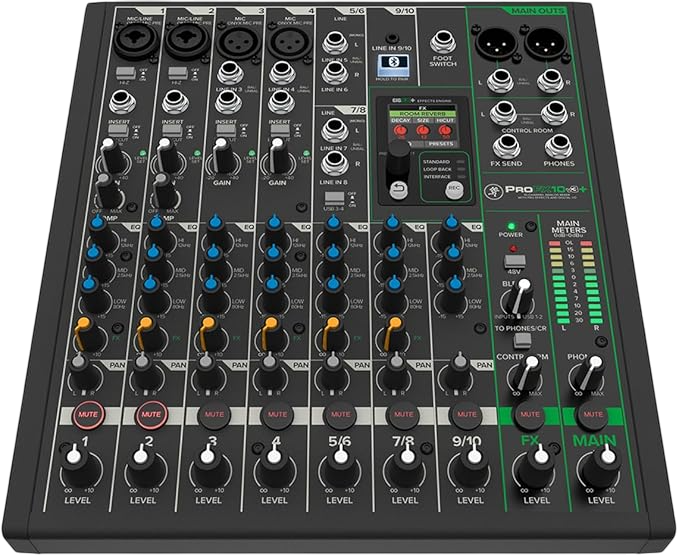
For streamers, the real magic is in the USB interface. It runs at 24-bit/192 kHz and has three modes:
- Standard – send your whole mix to the computer.
- Loopback – perfect for streaming, it brings your computer audio back into the mix.
- Interface – sends just your raw mic channels into your DAW.
Then there’s the GigFX engine with 24 effects (reverb, delay, chorus, etc.), plus Bluetooth for taking a call or dropping in background music straight from your phone. That makes it super handy for podcasts or hybrid events where you’ve got both live and remote elements.
Build quality is what you’d expect from Mackie—“built like a tank”—so you can throw it in a bag and trust it for live shows, but it’s just as at home on a streamer’s desk. And you even get a free DAW (Waveform OEM) and plugin bundle to start recording right away.
In short: if you need one box that covers live sound, podcasting, and streaming without switching gear, the ProFX10v3 is a smart pick.
Why it wins: great for small gigs and streaming; good build and effects; Mackie’s Tracktion bundle sometimes included.
USB behavior: multitrack on many ProFX v3 models (check model), and reliable drivers. Low latency and straightforward routing.
What you’ll love: rugged build, good value, and simple live feature set.
Real drawbacks: some earlier driver versions had issues — update drivers before big shows. Check the exact model’s USB modes.
Ideal user: streamers who perform with musical guests or small live acts and want easy DAW capture.
7) Allen & Heath ZEDi-10 — Most reliable road/studio hybrid
When I first got my hands on the Allen & Heath ZEDi 10,
I had high expectations—it’s from a brand known for pro-level mixing consoles, after all.
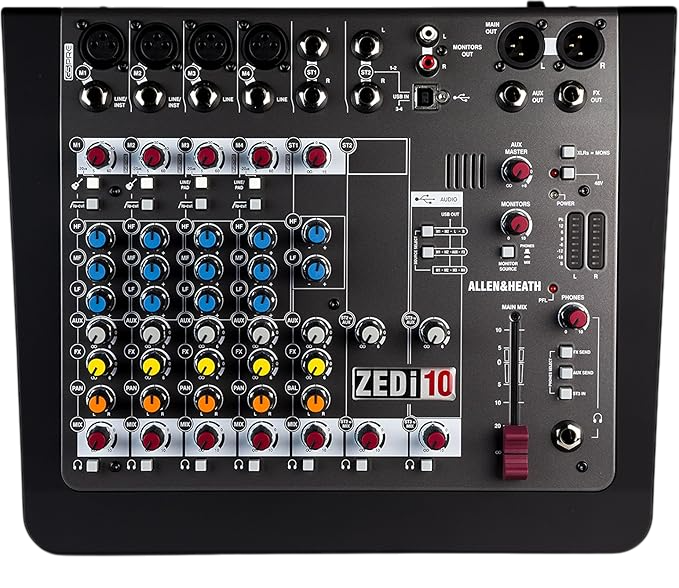
And I have to say, this compact yet powerful mixer didn’t disappoint… well, mostly.
If you’re hunting for the best mixer for podcasting, this one definitely deserves a spot on your list, but let’s break it down.
What Makes the Allen & Heath ZEDi 10 Stand Out?
Unlike many other budget-friendly mixers, the ZEDi 10 doubles as a USB audio interface (24-bit/96kHz), meaning you can plug it straight into your computer and record high-quality audio without needing extra gear.
That’s a huge plus for solo podcasters, interviewers, and even small music setups. But what really caught my attention was:
- Crystal-clear preamps – Allen & Heath’s GSPre boutique preamps deliver a warm, noise-free sound, something I instantly noticed when recording vocals. Compared to my old Behringer Xenyx, the difference was night and day!
- 4 mic/line inputs – If you’re running a podcast with guests, having multiple high-gain, low-noise mic inputs is essential. The ZEDi 10 handles that smoothly.
- Onboard EQ & effects – The 3-band EQ helps shape the sound right at the source, while the built-in FX send adds that extra polish.
- Sturdy, road-ready build – This thing is built like a tank. I’ve accidentally dropped it (don’t ask how 😅), and it didn’t even flinch.
Why it wins: Allen & Heath reliability, good preamps, compact desktop form.
USB behavior: multitrack USB (2TR + multichannel routing in some variants). Class-compliant modes for mobile use in many cases.
What you’ll love: build quality, stable drivers, and clear analog signal path.
Real drawbacks: fewer built-in podcasting features (pads/preset FX) compared to some dedicated podcast mixers.
Ideal user: session musicians, rehearsal spaces, and anyone who wants a sturdy, dependable mixer that doubles as an interface.
Comparison Table — Best USB Audio Mixers
| Mixer Model | USB Type (Stereo/Multitrack) | Loopback Support | Preamps & Sound Quality | Built-in FX / Processing | Class-Compliant (iPad) | SD Backup Recording | Ideal Use Case |
|---|---|---|---|---|---|---|---|
| RØDECaster Pro II | Multitrack (14+ channels) | ✅ Yes (advanced) | Excellent, low-noise | Full processing: EQ, comp, de-esser, noise gate | Limited (mobile works, some features reduced) | ❌ No (USB only) | Pro podcasting, streaming with advanced routing |
| RØDECaster Duo | Multitrack (similar to Pro II, fewer ch.) | ✅ Yes | Excellent | Same as Pro II (EQ, comp, FX) | ✅ Yes | ❌ No | Compact desk podcasting / dual-host streams |
| Zoom PodTrak P8 | Multitrack (via USB + SD) | ✅ Yes | Good, clean preamps | Basic EQ & limiter | ❌ Not full class-compliant | ✅ Yes | Portable podcasting, on-the-go interviews |
| Behringer Xenyx 1204USB | Stereo USB only | ❌ No | Decent for budget level | Basic compression, some FX | ❌ No | ❌ No | Entry-level users, budget streaming |
| Yamaha MG10XU | Stereo USB only | ❌ No | Strong, clean Yamaha pres | Good quality FX (chorus, reverb) | ❌ No | ❌ No | Small bands, hobbyists, simple streaming |
| Mackie ProFX10v3 | Multitrack (depends on model, up to 2×2/4×4/12×4) | ✅ Yes (OBS friendly) | Solid, warm Mackie pres | Onboard FX, Tracktion software included | ✅ Yes | ❌ No | Streaming + small gigs, hybrid setups |
| Allen & Heath ZEDi-10 | Multitrack (4×4 over USB) | ❌ No (workarounds only) | Studio-grade, very clean | No onboard FX | ✅ Yes | ❌ No | Rehearsals, studio tracking, reliable live use |
📌 How to read this table
- USB Type → Multitrack = each mic/instrument goes to your DAW separately. Stereo = all mixed down into left/right.
- Loopback Support → Needed for streaming (mic + system audio to OBS/Zoom cleanly).
- Class-Compliant → Means plug-and-play with iPad/iPhone without drivers.
- SD Backup → Lets you record even if your laptop crashes.
- Ideal Use Case → My recommendation based on workflow fit, not just specs.
Which one should YOU buy? (decision tree — read like a flowchart)
Answer these fast, and I’ll point you:
- Do you need to edit each mic separately later?
- Yes → Multitrack is required. Look at RØDECaster Pro II, Duo, Zoom PodTrak P8, Mackie ProFX v3 (model check), or Allen & Heath ZEDi-10.
- No → Stereo USB is OK. Yamaha MG10XU or Behringer Xenyx 1204USB will work well.
- Do you stream with game audio and need clean mix-minus?
- Yes → prioritize loopback quality: RØDECaster Pro II, Zoom PodTrak P8, Mackie ProFX (v3 with loopback), or mixers with dedicated loopback routing.
- Will you run on iPad mobile setups?
- Yes → pick class-compliant mixers (RØDECaster Duo works; check device support) or those explicitly stated as iOS-compatible.
- Budget tiers:
- Entry (<$300): Behringer Xenyx 1204USB, Yamaha MG10XU (used deals).
- Mid ($300–$700): Mackie ProFX10v3, Zoom PodTrak P8.
- Pro ($700+): RØDECaster Pro II, larger Tascam/Zoom multitrack boards.
If you already own a quality audio interface: consider whether you need physical faders and pads. Sometimes an audio interface + a small analog mixer for foldback is cheaper and clearer than a big USB mixer.
Setup blueprints — save hours of trial & error
Here are exact, copy-pasteable setups for common workflows.
Streaming with OBS (game audio + mic)
- Send mic channels to a stereo USB mix or to a loopback USB pair depending on the mixer.
- In OBS, set the audio input to the mixer’s loopback device (not the mic channel directly) so you get game audio + mic in one channel.
- Mute local monitors that feed the stream to avoid feedback.
- If multitrack, route game audio to a separate USB channel so you can lower it in post.
Call-ins (Zoom / Skype / Phone) — mix-minus
- Route the caller to an aux/monitor so the host can hear them.
- Create a mix-minus output that excludes the caller’s audio and send that to the USB return that goes into the call app.
- Test for echo: if you or the caller hear echo, reduce loopback gain and enable single-way monitoring.
Mobile iPad podcasting
- Use a class-compliant mixer or enable class-compliant mode in the mixer’s settings.
- Use a powered USB hub if the mixer is not bus-powered or if you have many peripherals.
- Use the Apple Camera Kit for Lightning devices or a USB-C connection for newer iPads.
Live + record hybrid
- Use the mixer’s multitrack USB to capture all channels into your DAW.
- Send FOH as a stereo sum to the house and use aux sends for monitor mixes.
- Always record a backup (SD onboard or a separate recorder) if possible.
Sound quality, simplified — what changes your tone
Short answers you’ll actually use:
- Preamps matter. Cleaner preamps = less need for post EQ and less audible noise when you push gain.
- Mic gain vs inline gain boxes. If you use an SM7B you might need a Cloudlifter or a powerful preamp. Don’t blame the mixer until you’ve checked input gain headroom.
- Built-in processing: Good on the RØDECaster family — compressors, limiters, de-esser tuned for speech. On analog mixers it’s usually better to keep processing external or in your DAW.
- Noise troubleshooting: Hiss often comes from gain staging; hum often comes from ground loops (try ground lifts or balanced cables); USB whine often needs an isolated USB hub or a different cable.
Latency tiers — when monitoring is usable
- < 10 ms: Comfortable for live monitoring with light plugins (compression/EQ).
- 10–20 ms: Fine for speech; musicians may notice timing.
- > 20 ms: Use direct hardware monitoring for tracking musicians; use software monitoring for rough checks only.
If you plan to use real-time plugin processing (vocal processors, emulations), aim for a mixer/interface that supports very low buffer sizes and solid, driver-based ASIO/CoreAudio performance.
Frequently asked questions (short, direct)
Mixer with USB vs audio interface — what’s the difference?
A mixer centers on live routing and hardware controls. An interface focuses on converters and low-latency multitrack capture. Many USB mixers combine both, but interfaces often offer better specs per dollar for pure studio recording.
Do I need multitrack?
If you want to edit each mic later (remove coughs, fix EQ per mic), yes. For single-host dialogue mixed live, stereo is often fine.
Will my mixer work on iPad/Android?
If it’s class-compliant it likely will. Check the manual for sample rate and power requirements.
Do built-in effects matter for speech?
Light processing (gentle compression, de-essing) is useful. Heavy reverb or guitar effects usually aren’t.
Can I record to SD and send USB to my computer at the same time?
Some mixers allow this (Zoom PodTrak P8, Tascam Model 12, etc.). Check the model — it’s a valuable redundancy feature.

TL;DR recommendations (no fluff)
- Best overall / podcasting: RØDECaster Pro II — deep features, multitrack, loopback.
- Best compact: RØDECaster Duo — pro features in small package.
- Best portable: Zoom PodTrak P8 — SD backup, phone integration.
- Best value (budget): Behringer Xenyx 1204USB — stereo USB and low price.
- Best small studio: Yamaha MG10XU — solid analog mixer, reliable USB stereo.
- Best hybrid/streamer: Mackie ProFX10v3 — live + DAW capture (verify model).
- Most reliable build: Allen & Heath ZEDi-10 — sturdy, stable drivers.
What we didn’t include (and why)
I excluded several popular large-format mixers because:
- They lack reliable USB routing (they may have an insert or stereo USB only).
- Their drivers are historically flaky, or they require optional modules for multitrack.
If a mixer can’t deliver low-latency, clean loopback, or multitrack when advertised, it fails the real-world test.
How to keep your USB mixer sounding pro for years
- Update firmware sparingly but promptly when it fixes issues.
- Use good USB cables; avoid cheap mass-market cables for mission-critical setups.
- If you get hum, try a ground lift or balanced cables; avoid daisychaining power strips.
- Keep a backup: SD card recorder or a secondary interface for long sessions.
Short practical checklist before you buy
- Do you need multitrack? Yes/No.
- Do you need true loopback for streaming? Yes/No.
- Will you use iPad/mobile? Yes/No.
- How many physical mic preamps do you need right now? (Count them.)
- Budget: entry / mid / pro — stick to models in that band.
Final words
If you’re buying for flexibility and futureproofing, prioritize multitrack USB and clean loopback. If you need simplicity and a small budget, a stereo USB mixer will work and save cash. Don’t fall for feature lists that promise everything — test the USB routing or watch demos of the exact loopback behavior for your use case.
There are some affiliate links on this page that will redirect you directly to the original products and services. Also by buying through those links you will be supporting us. So thank you ^.^
Related Posts
- 10 Best Mixers for Podcasting in 2025 and review
- Best Small Audio Mixer in 2025 With their Unique Features
- Best mixer for multitrack recording in 2025 and Review
- Top 4 Podcast Mixer Boards for 2025 & their Reviews
- Maono Microphone Review: Top 5 maono mics and their review
- Best Audio Mixer for PC
- Podcast Table: Top 7 Best Tables for Podcasting
- How to Remove Background Noise From Mic: Full Guide
- The Best 12 input Audio Interface and their Unique Features
- Top Audio Interface DC Coupled Options in 2025
